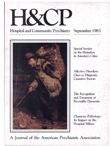A Psychiatric Profile of Street People Admitted to an Emergency Shelter
Abstract
During the winter of 1981-82 the City of Philadelphia operated an adult emergency shelter for two months. After reviewing the available records, the authors compiled a psychiatric profile of the 193 residents admitted to the shelter. They grouped the residents into three classes: habitual street people, the episodic homeless, and those who did not usually live on the street but were undergoing an acute crisis. Although a large number of the street people who suffered from diagnosable mental illness improved with adequate treatment, the authors found it was ext remely difficult to relocate many of the shelter residents. They discuss other problems such as the need for psychiatric expertise in treating the homeless and the lack of a coordinated effort among several city government departments.
Access content
To read the fulltext, please use one of the options below to sign in or purchase access.- Personal login
- Institutional Login
- Sign in via OpenAthens
- Register for access
-
Please login/register if you wish to pair your device and check access availability.
Not a subscriber?
PsychiatryOnline subscription options offer access to the DSM-5 library, books, journals, CME, and patient resources. This all-in-one virtual library provides psychiatrists and mental health professionals with key resources for diagnosis, treatment, research, and professional development.
Need more help? PsychiatryOnline Customer Service may be reached by emailing [email protected] or by calling 800-368-5777 (in the U.S.) or 703-907-7322 (outside the U.S.).



